Bougainvillea spp.
It’s easy to see why you’d want to include an enchanting bougainvillea in your landscape.
How many other plants produce showstopping color while simultaneously offering the gardener so many options, in a variety of forms?
You can shape and train it to grow as a vine, shrub, or small tree; frame a doorway or line a fence; let it drape across a trellis or pergola – it’s amazing what this tropical plant can do!
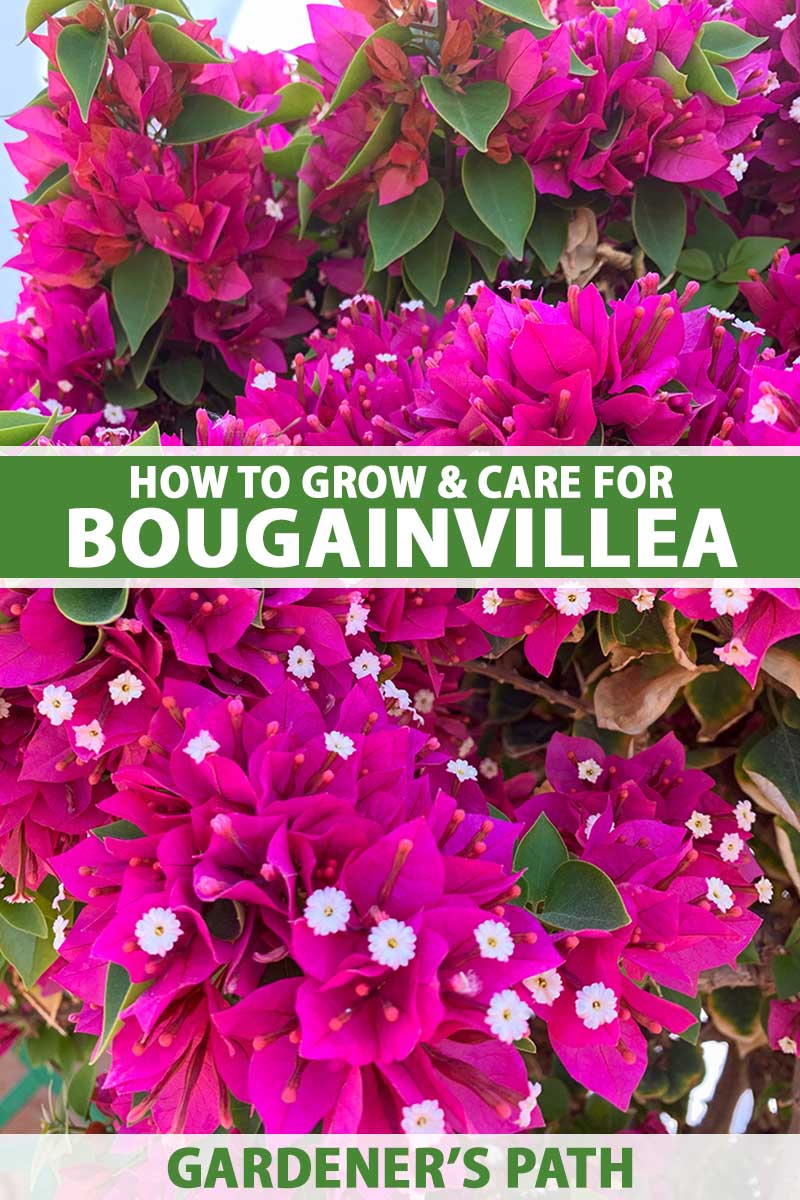
We link to vendors to help you find relevant products. If you buy from one of our links, we may earn a commission.
And those gorgeous, bright clusters of densely bunched blooms, practically covering the entire specimen – incredible!
But, wait – something about those “blooms” looks a bit strange. Could it be that we’ve been fooled? Aren’t those flower petals saturated with deep fuchsia, orange, yellow, and purple?
In fact, they’re not. The true flowers of these plants are actually tiny, and barely noticeable unless you get up close and personal with one – which you might not want to do because these perennials also sport some pretty attention-getting thorns.
So then, what are they?
Stick with me as we discuss that, caretaking tips, and so much more about the paperflower! Here’s what you’ll discover as you read on:
What You’ll Learn
Chances are, you’ve stumbled across a specimen that made such an impression that you simply had to learn more about it.

Whether you saw it online, in the neighbors’ yard, or at a garden center, it surely turned your head, and maybe even elicited some oohs and ahhs.
I remember thinking bougainvillea looked like something plucked right out of a fairytale the first time I saw one.
Let’s dive right in so you’ll be well prepared to install and care for one of your own at home.
What Is Bougainvillea?
It might be tough to see the resemblance, but the Bougainvillea (pronounced boo-gan-vill-ee-uh) genus belongs to the same family as four o’clocks – Nyctaginaceae.
This family also includes more than 30 genera and nearly 300 species, plus hundreds of cultivars, including trees, shrubs, vines, flowers, and herbs.
Depending on who you ask among the movers and shakers in the botanical world, there are as many as 20 accepted species in the Bougainvillea genus.

As natives of eastern South America – specifically Brazil and the surrounding countries – warm, humid growing conditions in USDA Hardiness Zones 10 and 11 are preferred.
Further north, or in unexpected cold snaps, protection or relocation indoors becomes necessary when temperatures dip near freezing.
Colloquially called paperflower (or paper flower) in reference to the texture of what appear to be its blooms, this tropical vine prefers slight drought, full sun, some extra nutrients, occasional pruning, and little else.
It thrives on neglect and begins to suffer and stops blooming with too much fussing on the part of the gardener.
In cultivation, three evergreen species and their cultivars are most commonly found: B. glabra, B. peruviana, and B. spectabilis, which was formerly known as B. brasiliensis – we’ll talk a bit more about these in our Cultivars and Species section, up ahead.
It can be challenging to tell the difference between these species because they have very similar traits, and even among the horticultural community, confusion persists.

There are also a few thornless cultivars on the market, such as the soft lilac ‘Silhouette,’ or ‘Miss Alice’ which is white.
All can be planted outdoors, potted as houseplants, or grown in containers to split time between both indoor and outdoor locations. Note, however, that they’re fast-growing, sometimes putting on more than 24 inches of length per year.
Now, about those “flowers…”
Anatomy
As I mentioned, the true flowers are tiny and white, with petals reminiscent of baby’s breath (Gypsophila spp.), and visible only from a close vantage point. They’re tube-shaped, but the tube portion of the flower is typically colored to match its surroundings.
They tend to simply appear to be a pistil, or the reproductive apparatus of a bloom, which is what we’re used to seeing in the center of most flowers.
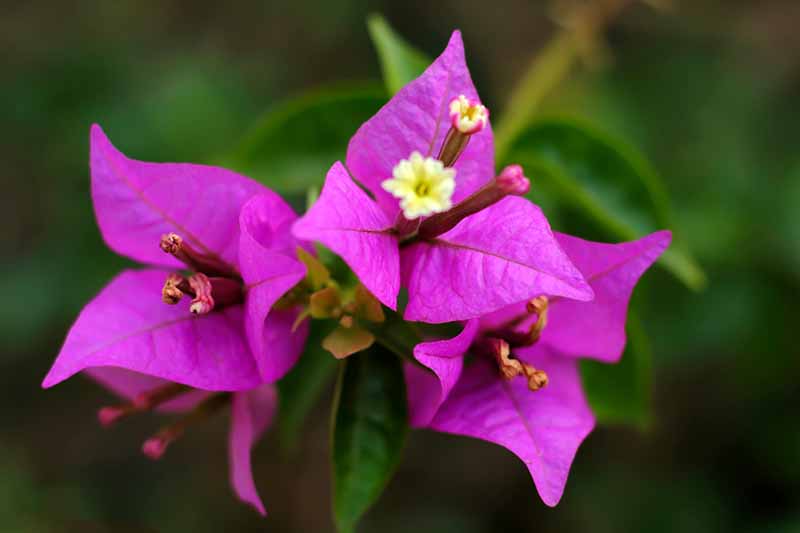
Blooms have short stems and terminal placement at the ends of branches surrounded by special leaves called bracts.
You’ve probably seen them before in poinsettias, bananas, and dogwood trees, among others, but their resemblance to flower petals makes it difficult to tell the difference.
Bracts are modified leaves, typically exhibiting bright colors, that protect the tiny blooms while also attracting pollinators to pay a visit – which they might not do as readily otherwise. They also double as protection for seed pods that balloon after the blooming period ends.
In warm, humid regions like the southern United States, blooming typically occurs in the winter, which adds some much-appreciated color during the blandest of months.
Aside from bracts, leaves are green and alternately placed along the long, sprawling canes characteristic of these species.
Typically, members of this genus are considered woody, evergreen vines, although they can also be deciduous in regions where winter temperatures are cooler.
Pruning to create other forms, such as shrubs or small trees, is a common landscaping practice in warm, humid regions all over the world.

Vines can easily spread to about 20 feet in length, or sometimes more, becoming woodier and heavier over time.
Keeping the size and shape in check with pruning should be balanced with allowing new growth to develop, as the colorful bracts will be more plentiful.
If the size is a bit overwhelming for the space you’ve got, consider the dwarf ‘Helen Johnson,’ which produces lush fuchsia bracts, or choose from the Sunvillia series with options in pale pink, creamy yellow to white, or dark pink.
Canes are twining and have no tendrils with which to climb, so they often use their thorns to grasp nearby structures in an effort to self-support.
But, as I mentioned, they can be very heavy and need additional support in most cases. They also have a shallow root system of no more than 10 to 12 inches with a slightly longer taproot, which doesn’t keep them upright on their own without pruning down to a small size.

Use caution in deciding what to attach them to so you don’t end up with a damaged fence, pergola, or house.
Note that bougainvillea poses a slight danger to pets and people, as all parts are mildly toxic if ingested. Thorns of up to a half inch in length can also give quite a poke, so avoid contact without sturdy gloves or skin protection – especially during pruning.
Next, we’ll briefly touch on some interesting history.
Cultivation and History
In the mid-1700s, a French botanist named Philibert Commerson traveled aboard a ship owned by his friend, Admiral Louis-Antoine de Bougainville.
During the voyage, which was planned to circumnavigate the globe and termed “The Bougainville Expedition,” they made a stop in Rio de Janeiro, Brazil.
Here, Commerson came upon two shockingly bright specimens that he later decided to rename in honor of his friend.
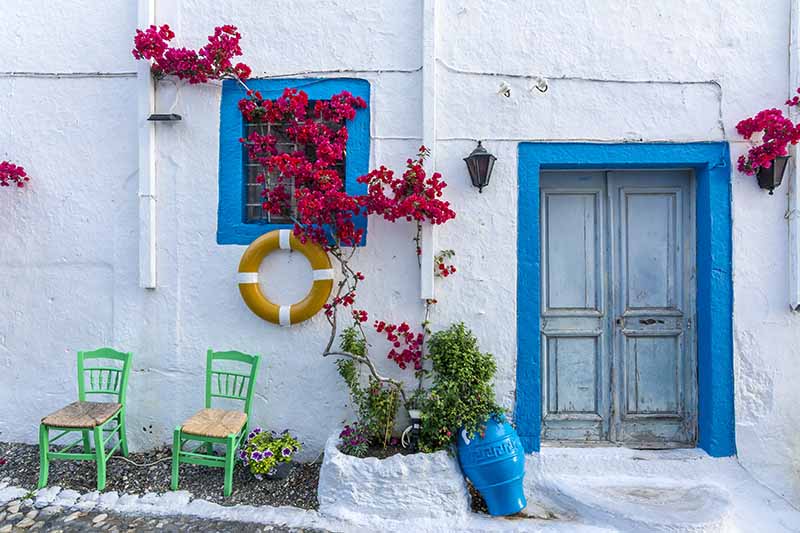
In Brazil, the plant was already referred to as “primavera,” which means “spring” in Portuguese, and throughout South and Central America, it was already a popular landscaping ornamental.
After returning to Europe with cuttings of the specimens, cultivation began with mild interest due to the low tolerance bougainvillea has for cold temperatures.
After several years, however, it gained some popularity in warmer regions, such as Greece and southern Spain.
It’s speculated that the Spanish conquistadors traveling to North America throughout the 1700s introduced either seeds or cuttings of the vine to southern California.
By the late 1800s, popularity exploded as horticulturists took notice, and by the early twentieth century, bougainvillea could be found growing throughout California and further east.
Soon, new colors became available as growers hybridized the species, producing cultivars such as ‘Double Red’ and ‘Vera Deep Purple.’
The vine is commonly chosen by allergy sufferers due its low pollen production, and by butterfly and hummingbird lovers, as it attracts both in scads.
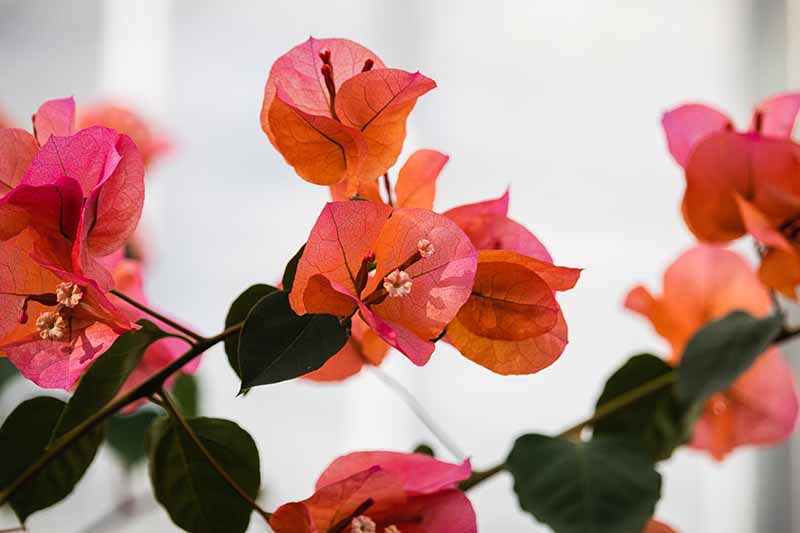
Because of hybridization, most bougainvillea plants are propagated by taking cuttings rather than planting seeds. In fact, some hybrids are sterile, and rooting cuttings is the only viable means of propagation for home gardeners.
Commercially, growers often turn to using tissue cultures to reproduce large quantities of varieties that are more difficult to grow from cuttings.
And with that, let’s move on to cover propagation at home.
Propagation
It’s rare to find viable seeds, or any seeds for that matter, produced by a bougainvillea specimen grown in cultivation.
Even though some species can be grown from seed to reproduce the same characteristics of the parent, such as those taken from species specimens rather than hybrids, the easiest way to clone parental traits is by rooting cuttings.
This is a similar process to what you might do when propagating other woody specimens like roses, camellias, and hibiscus.
It’s also a simple way to produce a lot of new plants, if you’re looking to save money on buying more or to cover a large area with them.
Taking cuttings is easy, but beware of those thorns! Wear thick gloves, like these rose gloves from Gardener’s Supply Company, which are designed to prevent pokes on both hands and forearms.
From Cuttings
Like other woody vines and shrubs, cuttings should be taken during periods of active growth. In warm climates, this may be throughout most of the year, but in others, late spring or early summer are the best times.
Cut a four- to-six-inch section from the end of a cane and strip about half an inch of bark from the cut end. Have a collection container ready to hold the thorny cuttings.
If there are flowers present, pinch or snip them off along with the top couple of bracts to divert energy to root formation.
Dip the stripped end in rooting hormone and stick loosely in a mix of one part sand to one part soil in a flat, or use individual pots that give them room to grow if you prefer not to transplant shortly after rooting.
Biodegradable pots are best since bougainvillea roots don’t like to be disturbed, and they’re brittle, so the risk of damage is significant during transplanting.
To preserve humidity, cover the pots or flat with a plastic bag, place the whole flat in a transparent storage tote, or sit it in inside a greenhouse.

Propagator with Humidity Vents
You could use this propagator with humidity vents, which acts as a mini greenhouse and is available from Amazon, or this Super Sprouter Deluxe that comes with a grow light, also available from Amazon.
Vent when condensation appears, to prevent overheating or rotting. Keep the cuttings in an area with a temperature in the 70 to 75°F range. Indirect sunlight is best and should be provided for four to six hours per day until growth begins.
It will usually take three months for new growth to begin, although it can sometimes take a bit longer. Keep the rooting substrate moist but not wet at all times as roots will not develop in dry soil.
After signs of new growth appear on your cuttings, move them to a spot where they’ll receive about eight hours of indirect sunlight per day.
Wait until about four to six new leaves have sprouted before transplanting to give the roots plenty of time to develop.
From Transplants
Avoid touching or squeezing the root system when transplanting as bougainvillea roots can be damaged easily.
If you’ve used biodegradable pots to propagate cuttings, simply leave them in place and transplant the entire thing. If not, remove the rooted cuttings from their tray or nursery pot very carefully.
If the permanent location is also a container, simply fill a vessel about three times as wide and deep as the root system with equal parts sand and loamy soil. Ensure that the container provides good drainage.
Propagated transplants and nursery plants that will be installed in the ground need an appropriate site – we’ll cover that more in the next section.
Make a hole about as wide and deep as the root system and gently place the rooted cutting or nursery specimen into the hole, at the same depth as it was previously planted, and backfill around it.
In either case, be sure to water well to settle the transplant into its new home, and make sure excess water drains away.
How to Grow
Even though it’s not the lowest-maintenance option, the effort required to care for paperflower vines is well worth it if you’re going for a luxuriant, impactful look. There are a few key factors to keep in mind, and we’ll cover them all.
Placement
Bougainvillea has shallow roots that spread laterally with a taproot that reaches only slightly deeper.
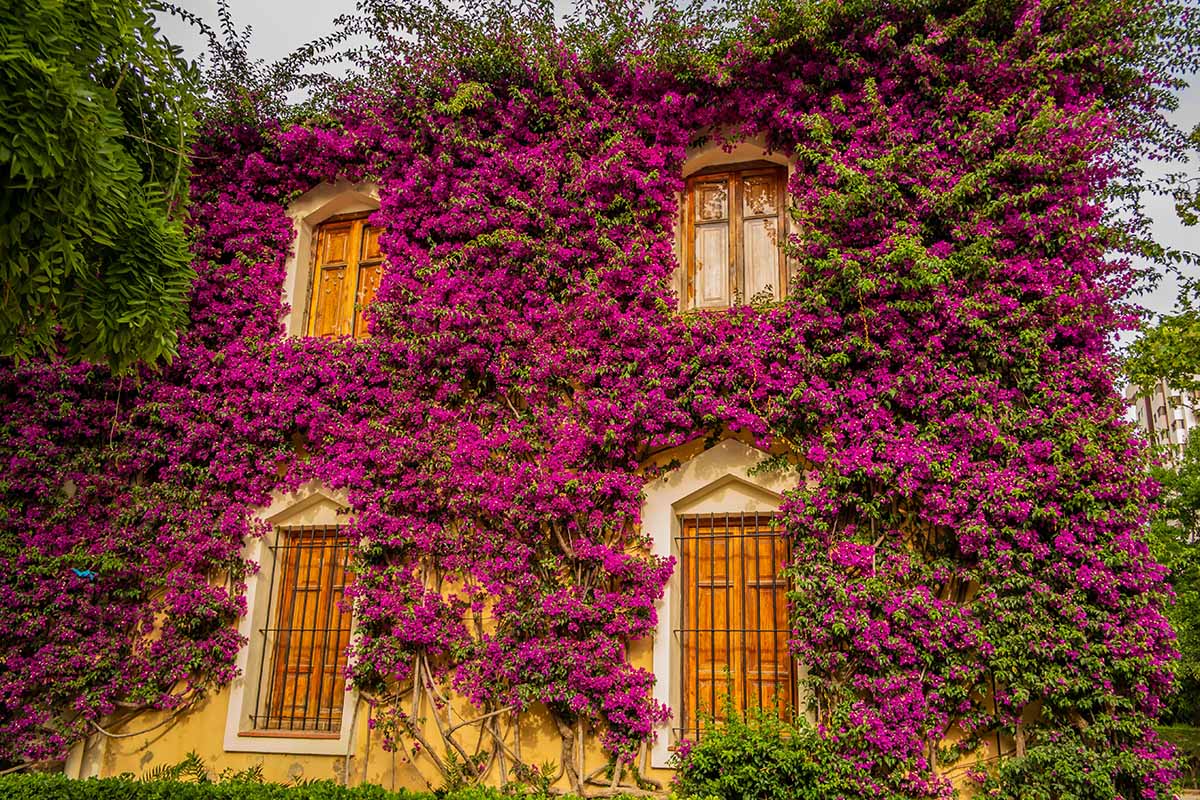
The lateral roots, however, can pose a risk to surrounding structures. Don’t plant close to a house or other structure where damage to the foundation, siding, or roof might occur.
Light
Choose a location with full sun exposure for at least eight hours per day.
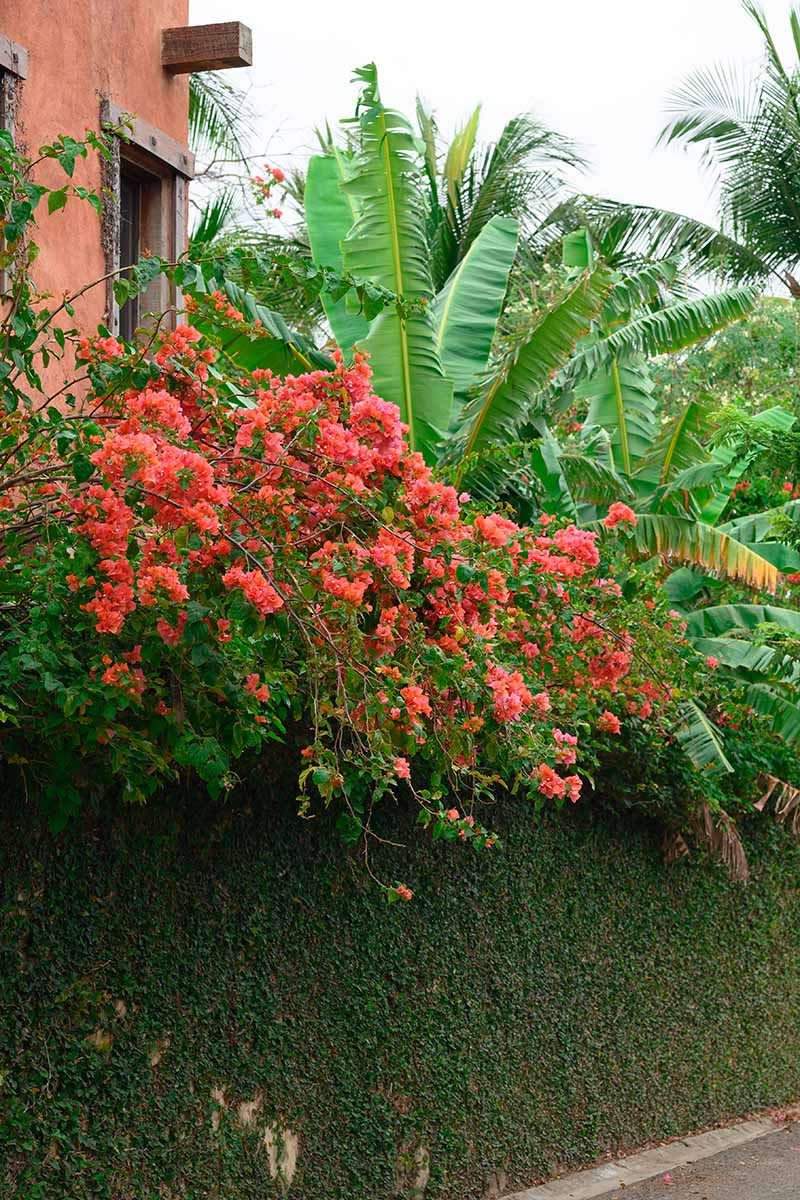
Without enough sunlight, signs of protest will become apparent, including leaf and bloom drop, few blooms, and fewer colorful bracts.
Soil
A mix of sand and loam is best, so amending prior to planting may be necessary to create ideal conditions.
Be sure that the soil does not retain too much moisture as these vines cannot tolerate soggy ground. Root rot becomes a concern, and can be deadly, if the substrate remains too damp.
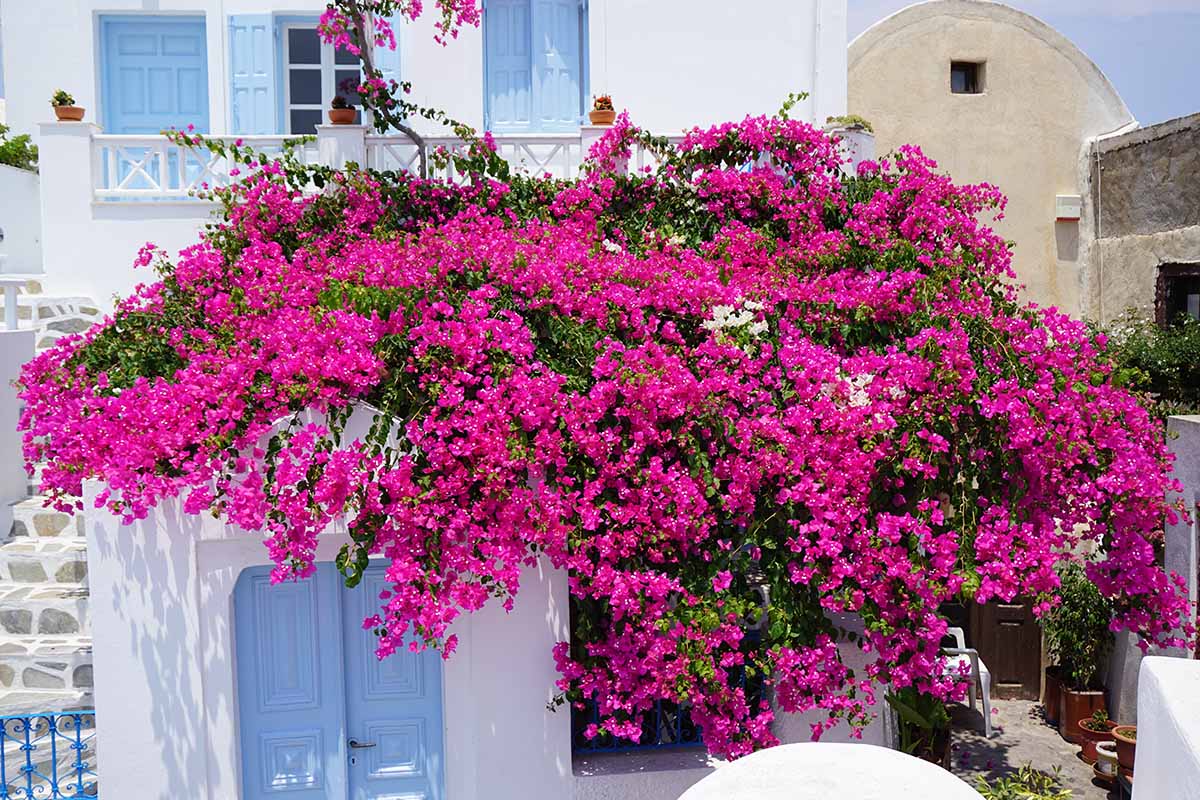
Ideal pH is in the acidic range between 5.5 and 6.5. If you’re unsure of the pH level of your soil, performing a soil test is an important step to avoid later pitfalls.
Since this vine needs slightly acidic soil, you can adjust both pH and drainage simultaneously by mixing finely shredded pine bark into the substrate at the time of planting to increase acidity.
Temperature
Ideal growing conditions are typically within Zones 10 and 11. Bougainvillea can also be grown outdoors year-round as far north as Zone 9 with winter protection provided for exposure to temperatures below 35°F in-ground, or about 50°F in a container.
The hardiest species is B. spectabilis, which is known to withstand temperatures down to about 20°F. If you live in a cooler zone, this might be the best option for you.
Water
In the absence of rain, supply a deep watering when the soil feels dry just below the surface. This may be weekly during the hottest times of year, or once every two to three weeks in cooler seasons.
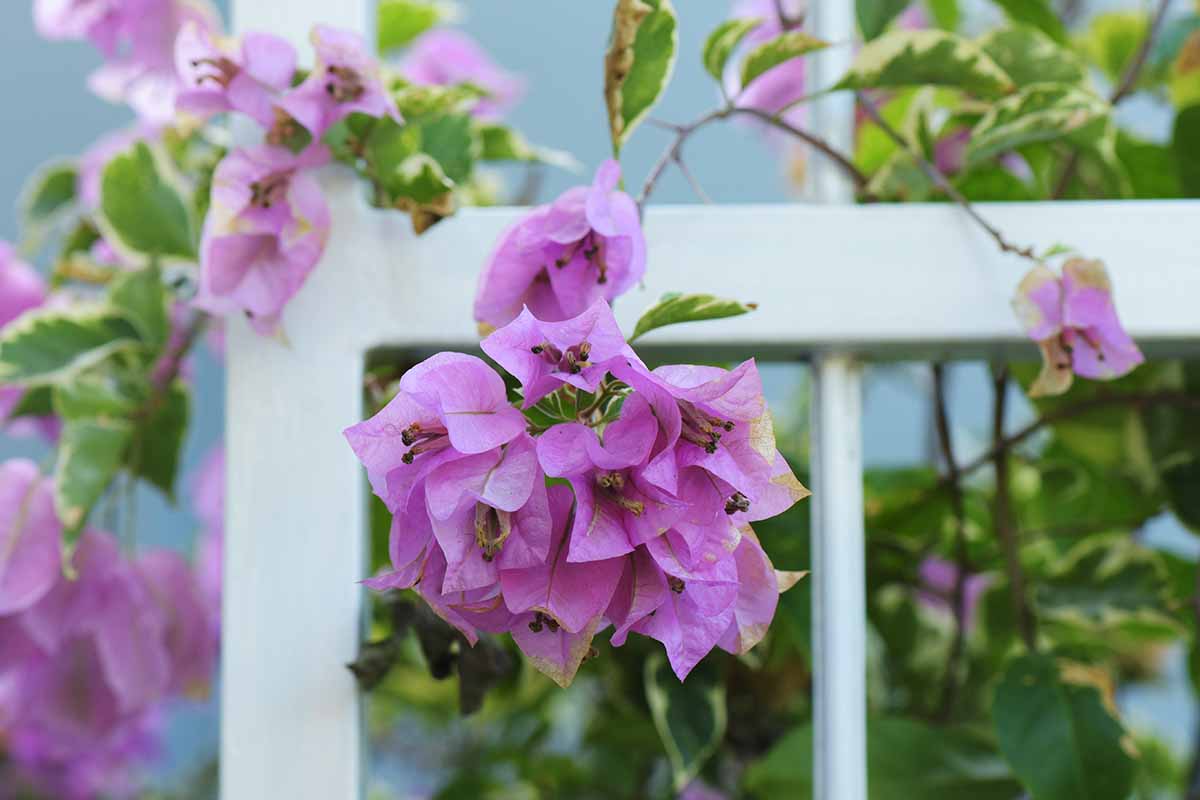
Be sure to avoid overwatering as this is a major culprit in reduced blooming and overgrowth of green foliage rather than flowers.
Support
Bougainvillea vines can grow up to 36 inches per year in ideal conditions, becoming very heavy over time. If you plan to allow them to grow to their full length, they’ll need strong support.

An arbor such as this Westwood Cedar Arbor is made of thick, sturdy wood that can be permanently installed with a poured concrete footing.
You can purchase it from VITA via Home Depot.
Or, if you aren’t a fan of the arch style and would prefer a rectangular arbor, this Carolina Embossed Vinyl Arbor, also from VITA via Home Depot, would make a lovely, sturdy alternative.
Training the vine to climb and creep along a fence or wall is possible as well, but be sure to keep it pruned to prevent it from engulfing the whole thing!
Container Planting
Even though most types can grow to large sizes, bougainvillea can also make a beautiful container planting. If you don’t want to deal with frequent pruning to control the size, a dwarf cultivar that remains compact might be the best choice.
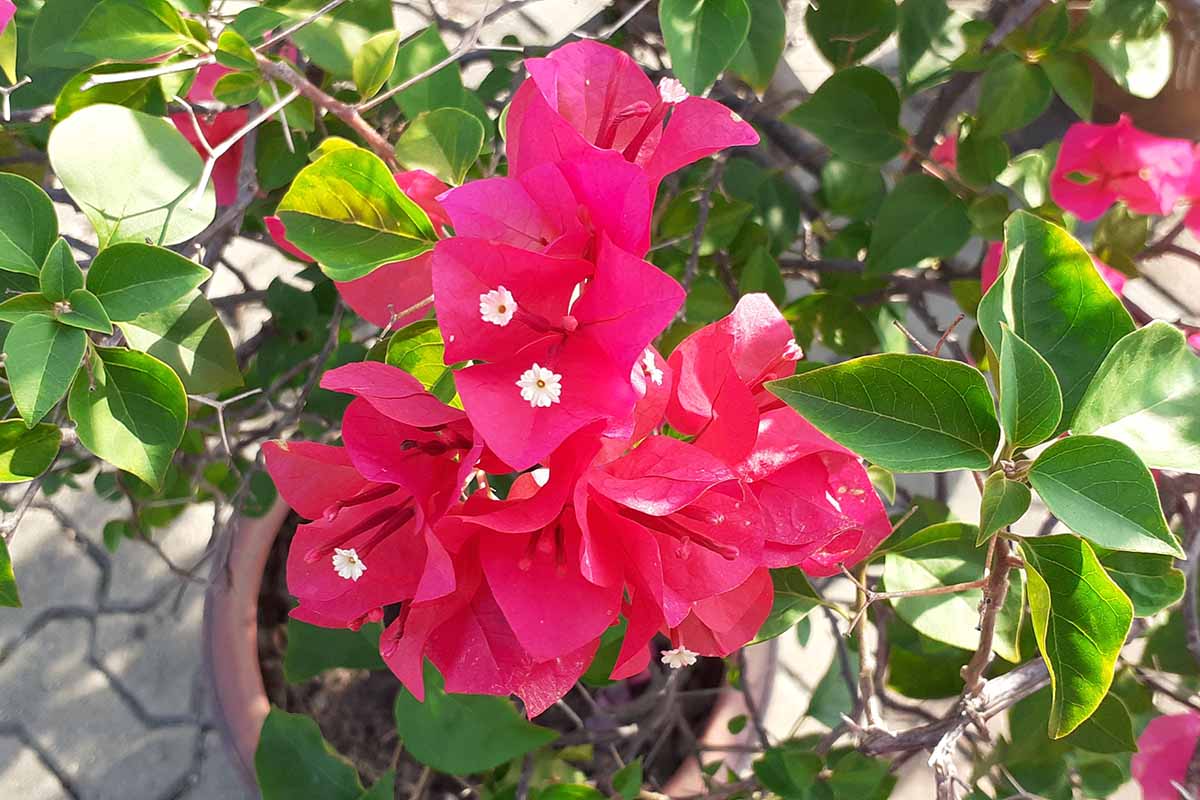
An unglazed ceramic planter is best since it transpires easily and doesn’t retain too much moisture – although, you’ll want to check often to make sure it hasn’t allowed the soil to dry out too much.
The container doesn’t need to be huge since plants of this genus prefer close quarters and don’t mind being a bit rootbound. A diameter two to three inches larger than the root system is usually sufficient.
It’s difficult for the roots to use excess water in a container with too much room to spare, resulting in the potential for overwatering and rot.
A vessel such as this Aeros Ceramic Urn, available in a 17-inch size in white or green from Terrain, is a perfect choice for larger specimens.
For smaller varieties such as dwarf cultivars, a container such as this Better Homes and Gardens Round Blue Ceramic Planter in a 12-by-12-inch size works well.
Find it at Walmart. Since it’s glazed, it’ll transpire a bit less readily.
Whatever pot you choose, ensure that it has proper drainage.
Fill the container to just below the brim with equal parts humus-rich potting mix and sand. Create a hole just slightly larger than the root system of the transplant. Seat it gently in the hole, backfill around it, and water it in well to settle.
Be sure that all excess moisture drains away to avoid later problems.
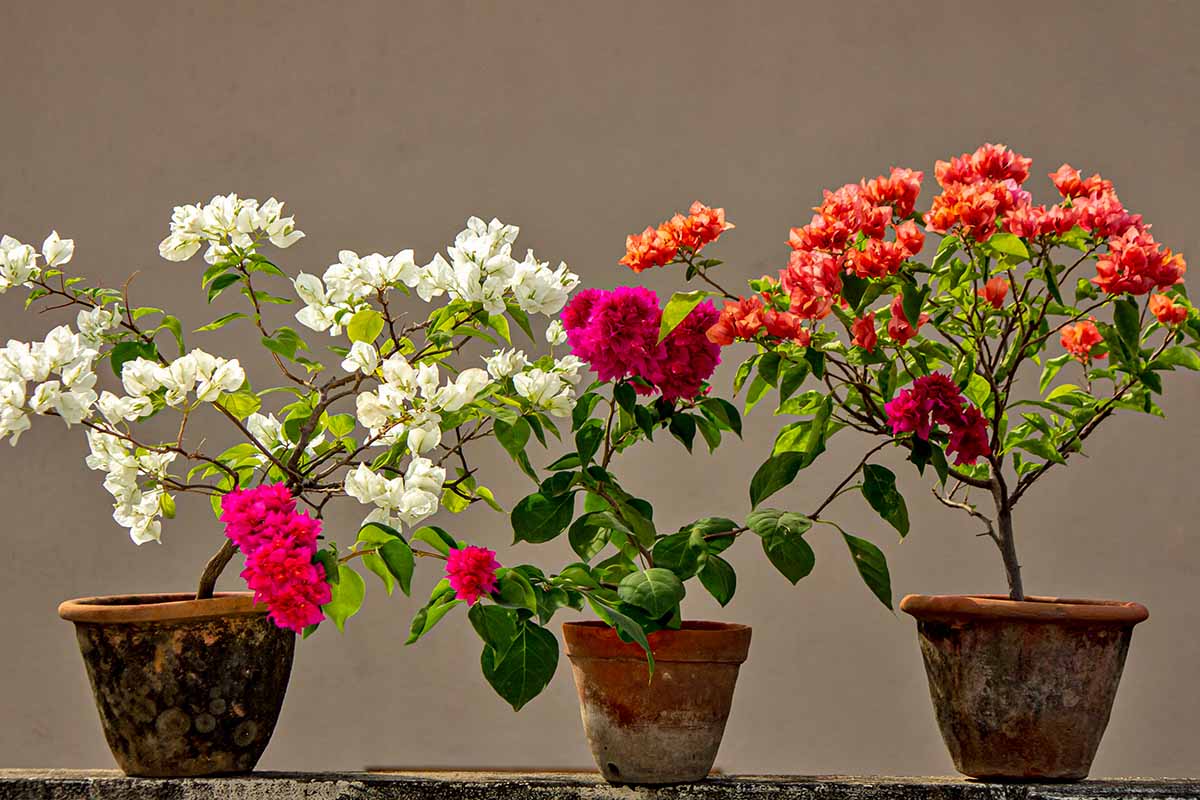
Use the same rules of thumb that we discussed in the previous section to select a site to place your planter. Bear in mind that, even though pots can be moved, they are rather heavy when filled with soil.
Another option for a potted specimen is bonsai, which is popular with these species.
Bonsai
Because of their dense, bushy structure, bougainvillea make absolutely stellar candidates for bonsai and they’re preferred by many who enjoy the hobby.
First, choose a bonsai pot and a cultivar to go with it. Dwarf varieties are easiest to train since they’re already compact, reducing the amount of pruning, root reduction, and defoliating that needs to be done to maintain their size and shape.
Parisian Red Ceramic Bonsai Pot
Containers made specifically for bonsai can be tricky to find, but expert suppliers like Bonsai Boy have hundreds of options available, such as this ridiculously gorgeous Parisian Red Ceramic Bonsai Pot with attached drip tray.
Or, if you’re not too keen on starting from scratch, Bonsai Boy has trees that are already established and ready to ship, like this flowering bougainvillea bonsai made from a dwarf ‘Pink Pixie’ cultivar.
A larger flowering red bougainvillea bonsai tree is also available from Bonsai Boy.
The art of bonsai requires some education – but that’s a topic best saved for another day! Let’s move on to discuss keeping your specimen healthy with regular feeding.
Fertilizing
Even though bougainvilleas aren’t fussy, they still need adequate nutrition to remain healthy and beautiful.
At the time of planting, top-dress with compost to increase available nutrients. Repeat the process every three to six months, but avoid burying the trunk.
For potted vines or trees, plant food spikes or slow-release granules work best to avoid buildup and burning in such a small space. It’s also best to add fertilizer to damp soil and water again after application to distribute the product.
Fruit and Citrus Fertilizer Spikes
Try these Fruit and Citrus Fertilizer Spikes, available in a four-pound package from Jobe’s via Home Depot.
With a 9-12-12 NPK ratio, they’ll boost color and blooming without contributing to foliage overgrowth and last for months.
Insert spikes in spring and fall, about 24 to 36 inches away from the trunk of the plant, at the outer edge of the root system. For potted plants, spikes should be inserted at the outer edge of the soil.
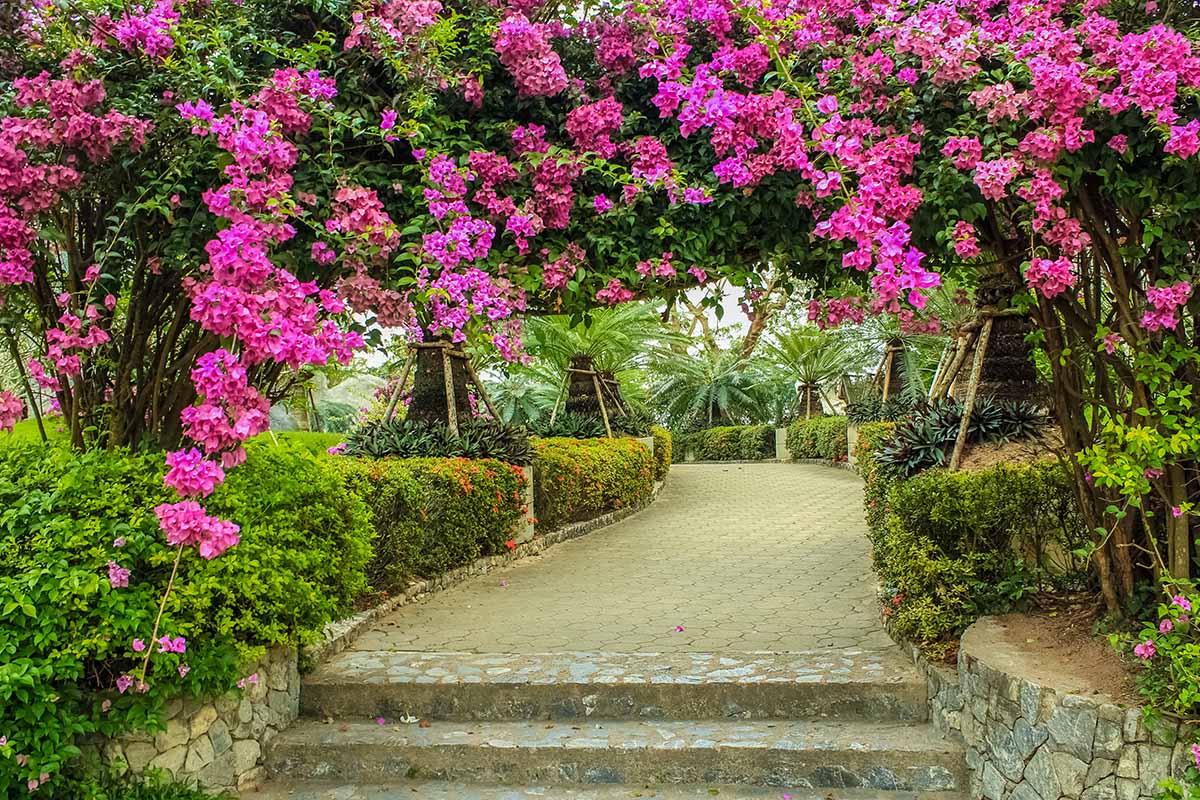
Liquid products typically provide nutrients for several weeks, while slow-releasing granules can last for several months.
After the first application in the spring, follow the instructions on the package to maintain a normal schedule. Typically, this means applying every two to four weeks through spring and summer.
BGI Bougain Bougainvillea Fertilizer is formulated specifically for the needs of these vines, with a 6-8-10 NPK ratio that provides nutrients to support blooming without encouraging excess foliage.

BGI Bougain Bougainvillea Fertilizer
It’s available in a two-pound package from Amazon.
Growing Tips
- Plant bougainvillea in full sun for optimum color and blooming.
- Use a strong structure that can support a long, heavy vine.
- Choose a dwarf variety for easy container care or bonsai.
Pruning and Maintenance
Time for a trim! The best time to prune bougainvillea in temperate zones is in the winter, typically just after it has finished blooming or within a few weeks.
Pruning too close to spring will reduce new growth and flowers, which appear at the terminal ends of the canes.
In warm, humid zones, wait until early spring or midsummer, as blooms typically appear in the winter in warmer regions.
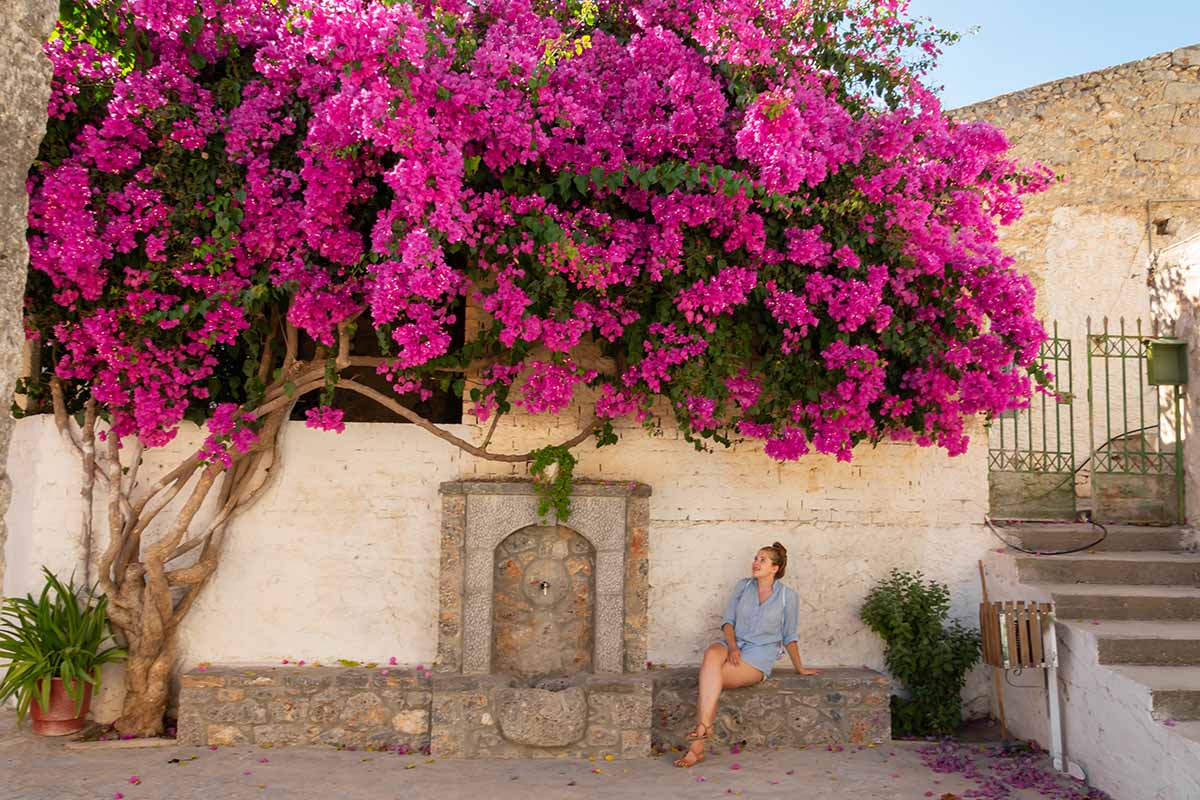
Hard pruning isn’t usually necessary unless the specimen has sustained significant infestation, disease, or damage, or become wildly overgrown.
In this case, it can be trimmed down during dormancy to two to four feet above the soil for a fresh start, but be sure to leave some leaf nodes intact.
Pruning into a tree form should be done in stages to avoid removing any more than 30 percent of the total canes at a time. Excessive pruning can lead to shock, which can be deadly.
Older specimens may need to have a few interior branches trimmed out at the trunk as they can become very dense, leading to die-off and disease spread. Creating space can improve airflow and penetration of sunlight.
If your bougainvillea is not blooming or the blooms are falling off, there could be several factors at play, such as overwatering, lack of sunlight, and more.
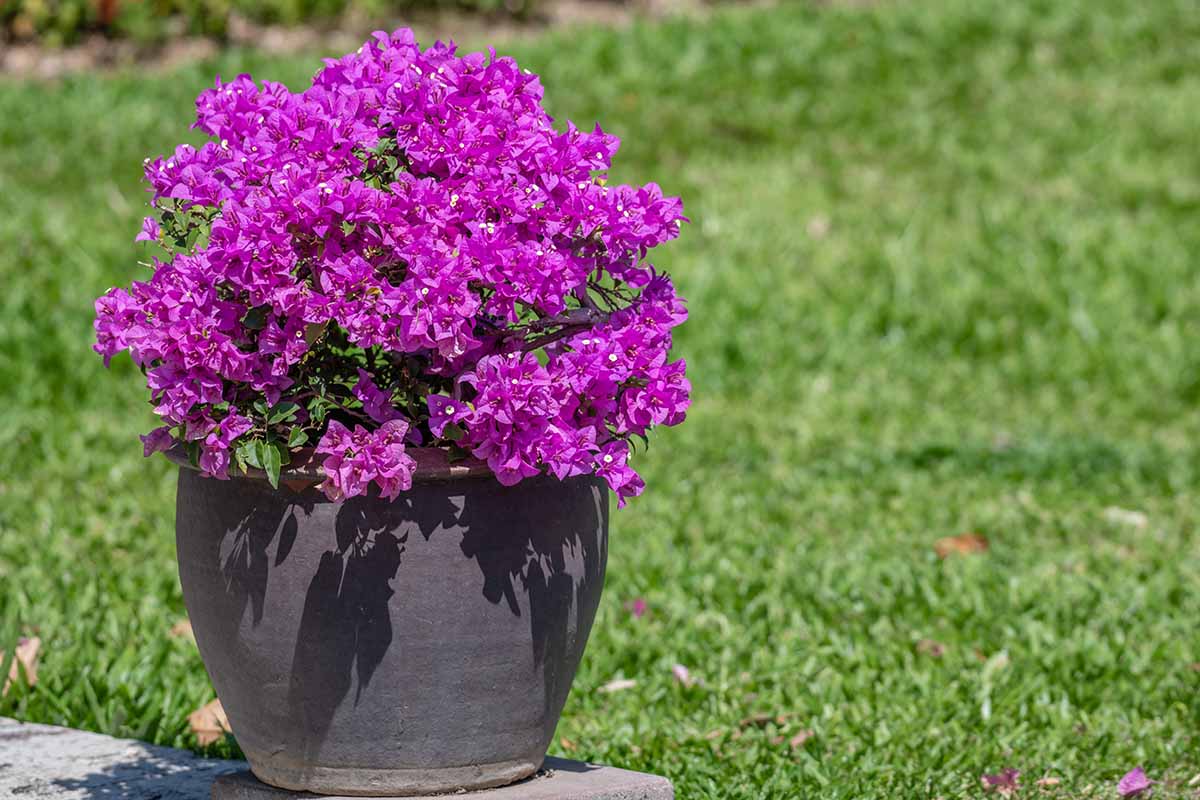
Sometimes there may be a bit of leaf drop after blooming ends. This is normal and is usually followed by a growth period, so don’t panic unless there are other signs of distress, such as discoloration or stunting.
We’ll cover how to look for signs of pests and disease a little later in this guide.
Cultivars to Select
There are three primary species available from most commercial sources, and numerous hybrids of each.

They all display brightly colored bracts, small blooms, and bushy foliage, but there are a few small differences between them:
B. glabra is also known as “lesser bougainvillea,” and is commonly chosen as a bonsai species. Bracts come in a variety of colors including red, yellow, purple, and pink, and the floral tubes have a pentagonal shape.
B. peruviana is also known as “buganvilla,” from the Spanish spelling. It displays smaller bracts in magenta or purple.
B. spectabilis is also known as “great bougainvillea,” and was formerly classified as B. brasiliensis.
It’s a popular landscaping choice due to its larger bracts in fuchsia, purple, and white. It also displays rounded floral tubes. This species is more cold hardy, surviving temperatures as low as 20°F.
With this in mind, take a look at just a few of the cultivars available today. Let us know which one you like best in the comments!
Barbara Karst
We’ll lead with one of the best-known, most widely cultivated hybrids around. With deep pinkish-red or magenta bracts, B. x buttiana ‘Barbara Karst’ is a gorgeous option for outdoor planting in Zones 9 to 11.
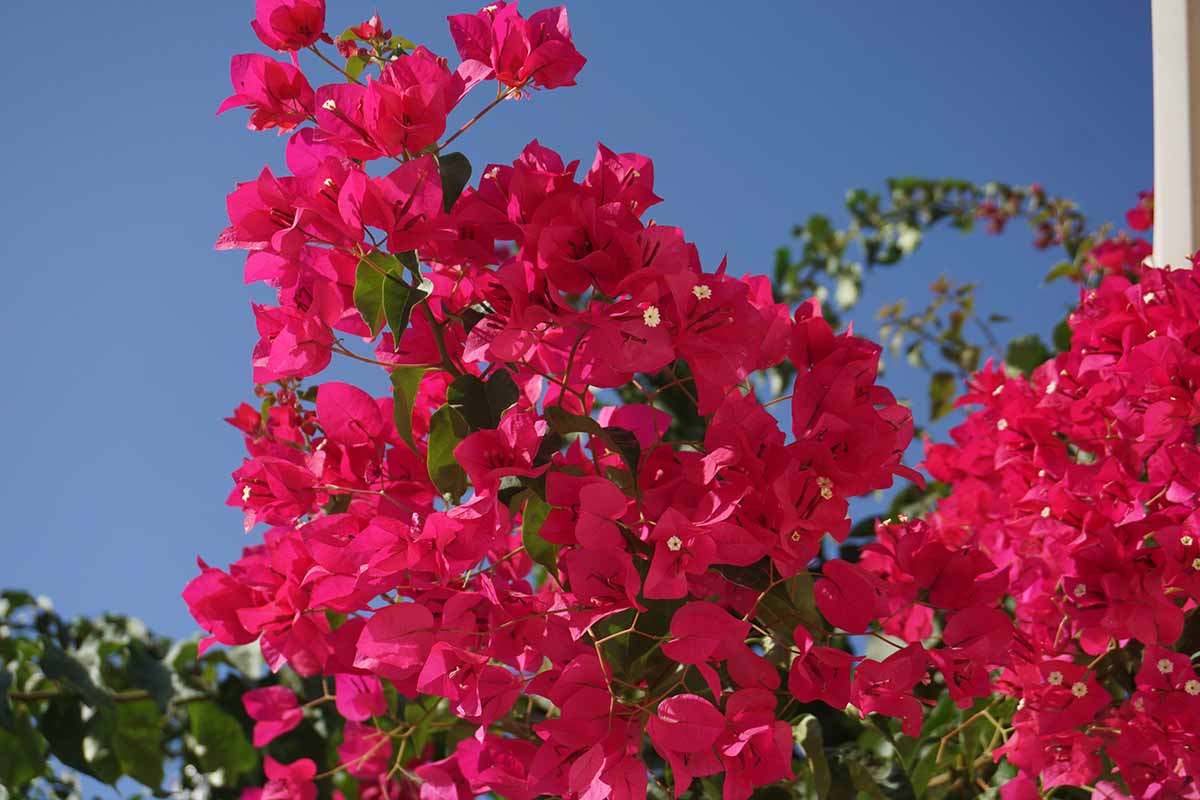
Now, Barb is not the one to install if there’s limited space available in your landscape – this cultivar can reach huge proportions, sometimes growing more than two feet per year and achieving well over 20 feet in height, with an equal spread.
Placing this one in a small area will lead to constant battles to keep it pruned and under control.
Instead, add her in a spot where she can grow and drape more freely, such as a large retaining wall or a heavily reinforced balcony, and save yourself the hassle!
This lovely lady can be purchased at FastGrowingTrees.com.
California Gold
Otherwise known as ‘California Gold Sunset’ or simply ‘Sunset,’ this hybrid is a cross between B. glabra and B. peruviana. The result is a plant with large bracts in a dreamy golden-orange tone and a vigorous growth habit.

And, boy, do I mean vigorous! In full sun, this specimen can reach upwards of 30 feet in height if left untamed! Prepare to keep it in check with regular pruning if you don’t have a wide-open, reinforced space where it can spread at will.
‘California Gold’ is best suited for growing in Zones 10 and 11, or in Zone 9 with adequate cold protection.
Four- to six-inch plants can be purchased from Amazon.
Rose
Dwarf varieties are hard to come by – until recently, there was only one available, the deep magenta ‘Helen Johnson.’
But now, with the introduction of the Sunvillea series, there are more options! One of these is another magenta beauty known as ‘Rose.’
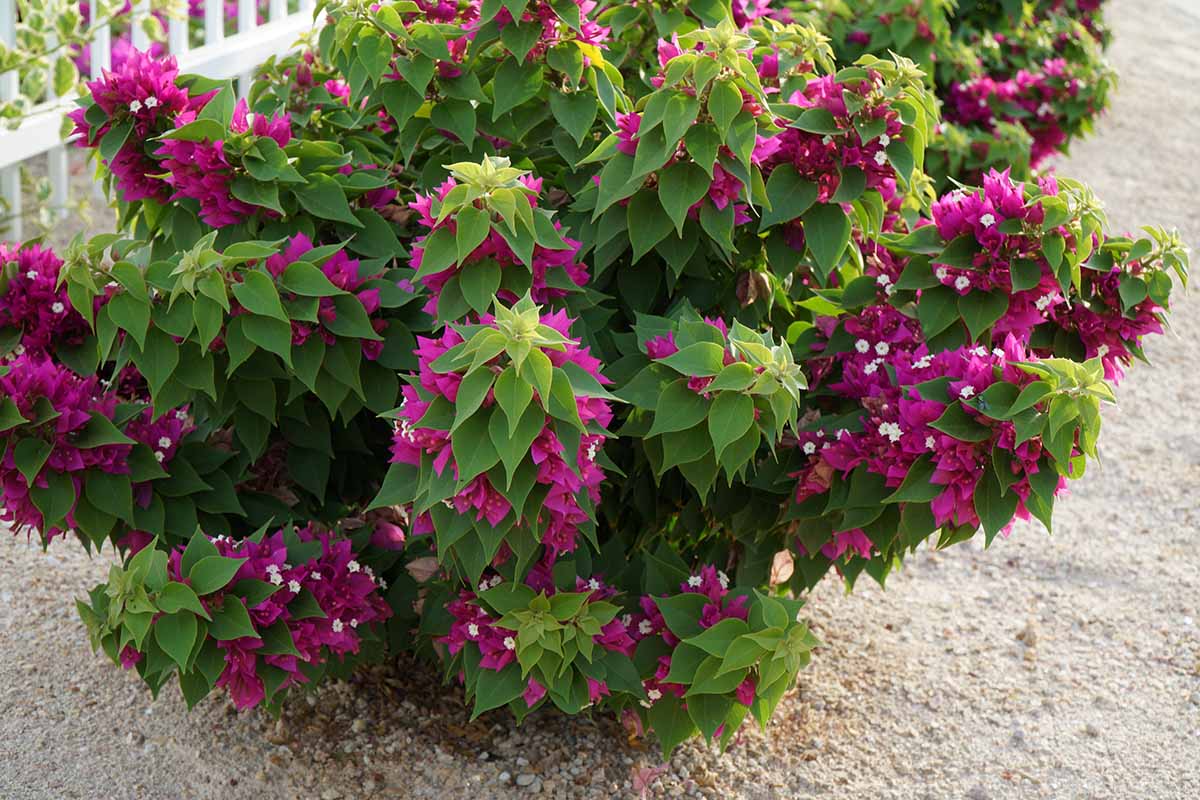
In most instances, ‘Rose’ reaches no more than about three feet in height at maturity, with the same size spread. Perfect for a bonsai or a potted accent for the porch or deck, this cultivar won’t need much pruning!
As with most specimens, ‘Rose’ is hardy in Zones 9 to 11, but should be protected from temperatures below 35°F if grown in the ground, or 50°F if potted.
Thai Delight
If you’re a fan of pastels over shocks of bright colors, then B. glabra ‘Thai Delight,’ also known as ‘Imperial Delight’ or ‘Imperial Thai Delight,’ could be a good choice for you.
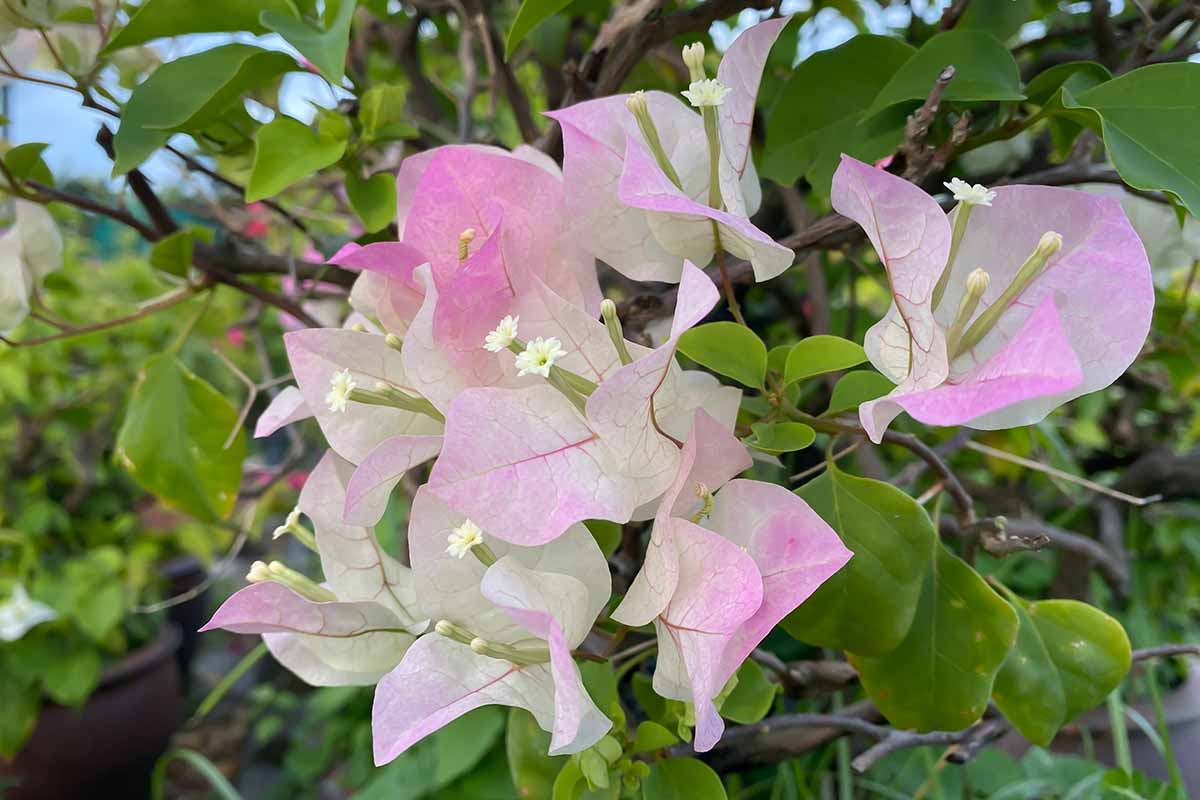
The soft, ethereal pink and magenta bracts would be a perfect addition to a zen garden or quiet patio with a pergola.
This cultivar is also a less difficult specimen to manage in terms of mature size, with an average height of 10 to 15 feet and a similar spread.
It’s also safe to plant ‘Thai Delight’ outdoors in Zones 9 to 11, although it does require frost protection in cooler regions.
You can find two- to three-foot plants available from FastGrowingTrees.com.
White Stripe
The words “delicate” and “airy” may come to mind when you lay eyes on B. spectabilis ‘White Stripe.’ This elegant, variegated cultivar displays large, bright white bracts with green and cream foliage.
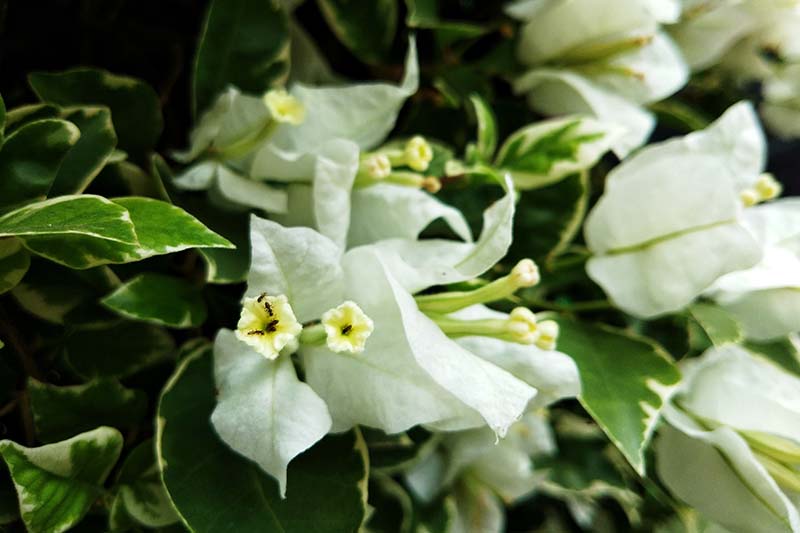
As a midsized variety, ‘White Stripe’ typically remains under 20 feet tall at maturity, with an average height of about 10 to 12 feet.
In Zones 9 to 11 it can be grown outdoors in-ground throughout the year, or in containers if carefully pruned for size.
Now that you’ve got some ideas as to what is available on the market today, we’ll go over the potential issues to expect from pests and diseases.
Managing Pests and Disease
As I mentioned, bougainvillea is both thorny and mildly toxic, and this combination is helpful in keeping tempted critters from sneaking a taste of the foliage.
There are very few of concern, though you might see the occasional signs that a deer has browsed a few leaves.
Aside from that, rats may nest among the dense foliage because it provides nearly impenetrable cover, protecting their young from predation by owls and other creatures.

If you live in an area where rats are known to exist in the wild, which they do in many places, it’s best to keep your vine pruned to create open space, which will encourage them to take shelter somewhere else – unless you don’t mind a rent-free rat family squatting in your yard!
Insects
Unfortunately, there is quite a laundry list of pests that could potentially show up for some free food.
Aphids, leaf miners, scale, slugs and snails, spider mites, and thrips may pay a visit now and then. You can read our guides for dealing with all of these, but it’s important to note that most won’t do enough damage to be concerned with.
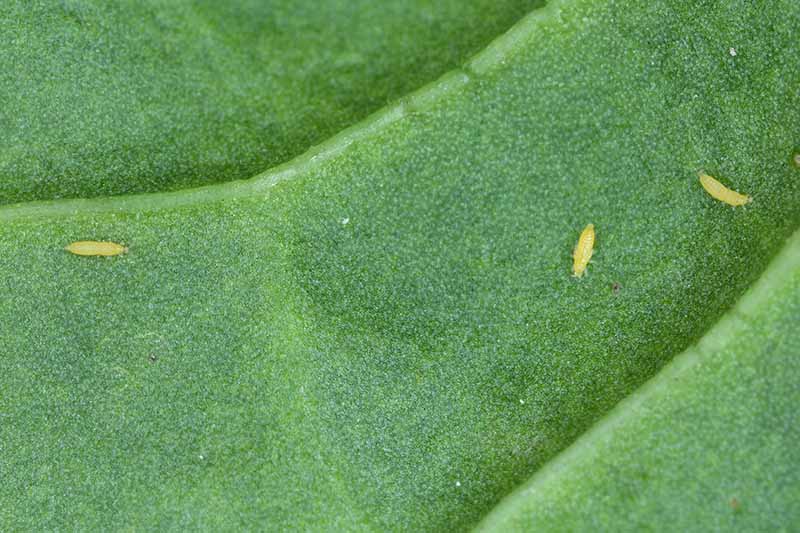
Aphids can cause stunting if they attack a young specimen, as they suck the fluids from the interior of the stems and leaves, but paperflower is a strong and durable plant, and won’t go down easily.
Bougainvillea Looper
The only serious insect pest to watch out for is the bougainvillea looper, Disclisioprocta stellata.
When it’s warm outside, they hatch forth from eggs laid on leaves by one-inch-wide, brown moths that are mainly active at night. From the moment they hatch, they can consume a great deal of foliage.
The caterpillars are yellow to brown and only reach about one inch in length before they pupate. Their bodies arch in the center as they crawl – hence the name, “looper.”
Damage from a looper looks like clean-cut, scalloped edges on foliage, chewed young shoots, and black or brown, wet frass left behind.
To prevent damage, spray with Monterey Bt at first sight – you can find 32-ounce spray or hose-end bottles at Arbico Organics.
The spray will be ingested by the larvae, where it will inhibit their ability to eat, causing them to die.
It’s also safe for most beneficial insects, and made from beneficial bacteria (Bacillus thuringiensis), so it’s a biological product rather than one that utilizes harmful chemicals.
Keep an eye out for new hatchlings and reapply if necessary.
Disease
Thankfully, the list of diseases that might attack your vine, shrub, or tree, is very short – but, unfortunately, the common culprits are not so easy to deal with.
Bacterial and Fungal Leaf Spot
Both types of leaf spots are caused by excessive humidity or moisture leading to the fast spread of bacterial and fungal pathogens.
Pseudomonas and Xanthomonas bacteria are common culprits, while fungal spores from numerous genera may be the cause. In either case, spots are rust to brown in color, turning black as they necrotize the underlying tissues.
Neither type can be treated after the infection has occurred, so the only way to prevent further issues is to prune away any infected material and dispose of it, either by burning where possible, or in a sealed trash bag.
As you remove the infected material, it’s helpful to clear some space through the thick foliage to allow more airflow. Doing so can help to prevent excess moisture from settling and reduce the spread of pathogens.
Bonide Liquid Copper Fungicide
Afterward, a spray of neem oil or copper fungicide, like Bonide Liquid Copper Fungicide, available in 16-ounce spray, 32-ounce hose-end bottles, or 16-ounce concentrate from Arbico Organics, can be applied according to package instructions.
Root Rot
Although it’s more common in container-planted specimens, root rot can occur with in-ground plantings as well. The chief cause of root rot is the spread of fungal pathogens or oomycetes due to overwatering.
Whether the spores belong to Rhizoctonia or Phytophthora genera, the results are the same – wilting, discoloration, and die-off occurring above ground, and blackened, slimy, smelly roots below. Detecting above-ground symptoms often indicates an advanced infection.
The only way to try to remedy this situation is to dig the root ball up and treat it. Do so carefully to avoid damaging the roots further.
Once it’s above ground, gently wash the soil away from the root system and allow it to dry well. Keep the root system out of harsh sunlight and wrapped with a tarp or burlap until you’re ready to address the issue.
Trim away any slimy, black, or decaying roots, and spray the whole root system with hydrogen peroxide. Discard the infected material in a sealed trash bag.
Allow it to dry again, and while you’re waiting, treat the planting site with a spray of copper fungicide as well.
It may be necessary to make amendments to the site prior to replanting, such as by adding sand and bark to allow for better drainage – or, if the site becomes soggy too often, it may be necessary to relocate the vine.
Best Uses
It’s so easy to let the imagination run wild and really get creative with bougainvillea.
Train it to frame a doorway with an arch of spectacular color, or let it creep along a strong fence.
Install a pergola or arbor and keep it neatly trimmed to shape, or add it to the top of a high retaining wall for a gorgeous cascade.
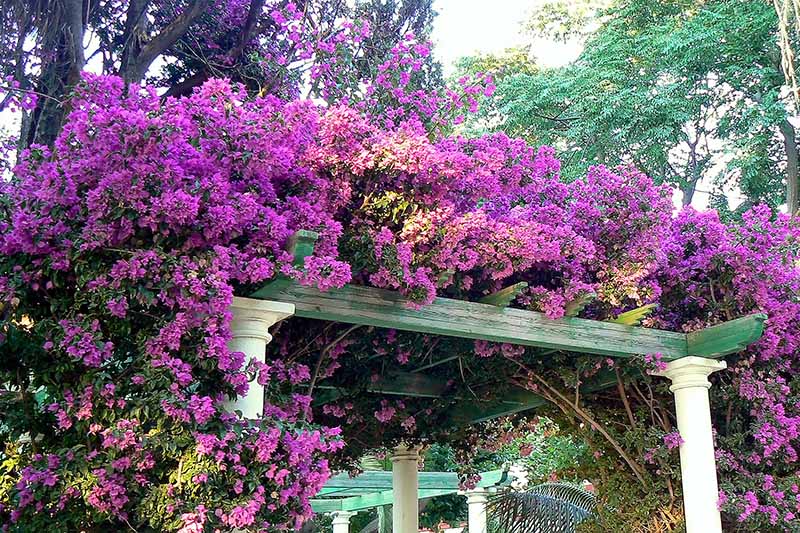
In large spaces where grass doesn’t grow well, it can be laid as a ground cover where it’ll fill in freely and quickly.
Shrubs can be shaped to resemble an azalea in bloom, or shaped into a short tree to act as the focal point in a bed or mass planting. Bougainvillea can also be added to a pollinator garden.
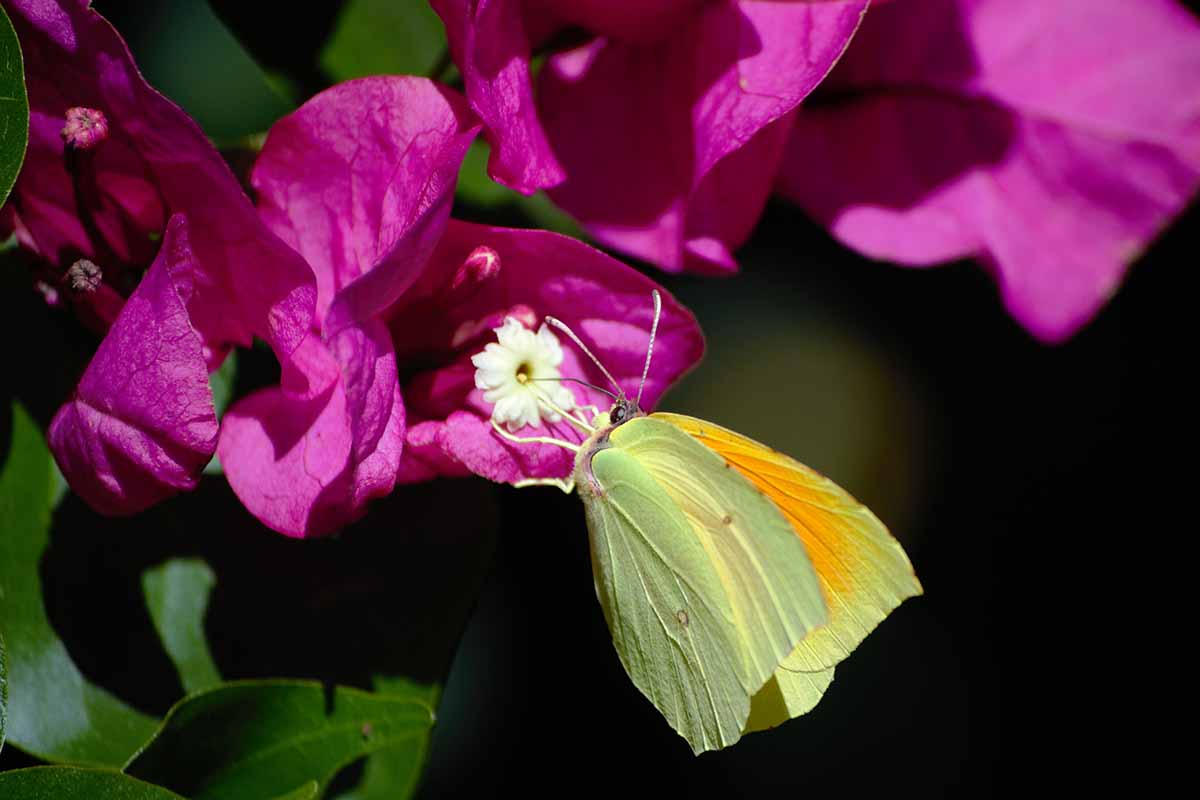
If you have the time and patience, an espaliered vine can be trained to grow along a frame to create a structured, geometric installation of bright tones. This technique can also be used to create a privacy barrier.
Or, simply let the vine climb between a patio or deck and a steel or wood-framed canopy for a low-effort screen or deterrent for intruders.
Bonsai is another option, as is container growing in general. As long as you keep the size and spread in check to maintain the dimensions you prefer, you really can do almost anything with these versatile specimens – but mind the thorns!
Quick Reference Growing Guide
| Plant Type: | Woody flowering vine or shrub | Flower / Foliage Color: | Lilac, magenta, orange, pink, purple, white, yellow/green, variegated |
| Native to: | South America | Maintenance: | Moderate |
| Hardiness (USDA Zone): | 9-12 | Tolerance: | Heat, full sun, sandy soil, mild drought, salt |
| Bloom Time: | Spring and summer (temperate zones); winter (tropical zones) | Soil Type: | Loamy, loamy sand |
| Exposure: | Full sun | Soil pH: | 5.5-6.5 |
| Spacing: | 2-3 feet | Soil Drainage: | Well-draining |
| Planting Depth: | Depth of root ball (transplants) | Attracts: | Bees, butterflies, hummingbirds, moths |
| Growth Rate: | Moderate to fast | Uses: | Bonsai, border, privacy barrier, defensive barrier, mass planting, focal point, ground cover, espalier |
| Height: | 20+ feet (except dwarf cultivars) | Order: | Caryophyllales |
| Spread: | 20+ feet (except dwarf cultivars) | Family: | Nyctaginaceae |
| Water Needs: | Moderate | Genus: | Bougainvillea |
| Common Pests and Diseases: | Aphids, caterpillars, leaf miners, scale, slugs, snails, spider mites, thrips; bacterial leaf spot, fungal leaf spot, root rot | Species: | Glabra, peruviana, spectabilis |
A Touch of Romance, But Mind the Thorns
I may have gotten a little carried away as I was writing this for you – how could I not?
Each species and cultivar is more gorgeous than the last, and I wanted to tell you all about each and every one!
Of course, you’ll find them too, as you shop for the one that will grace your home, but I like to be the one to make the introductions.
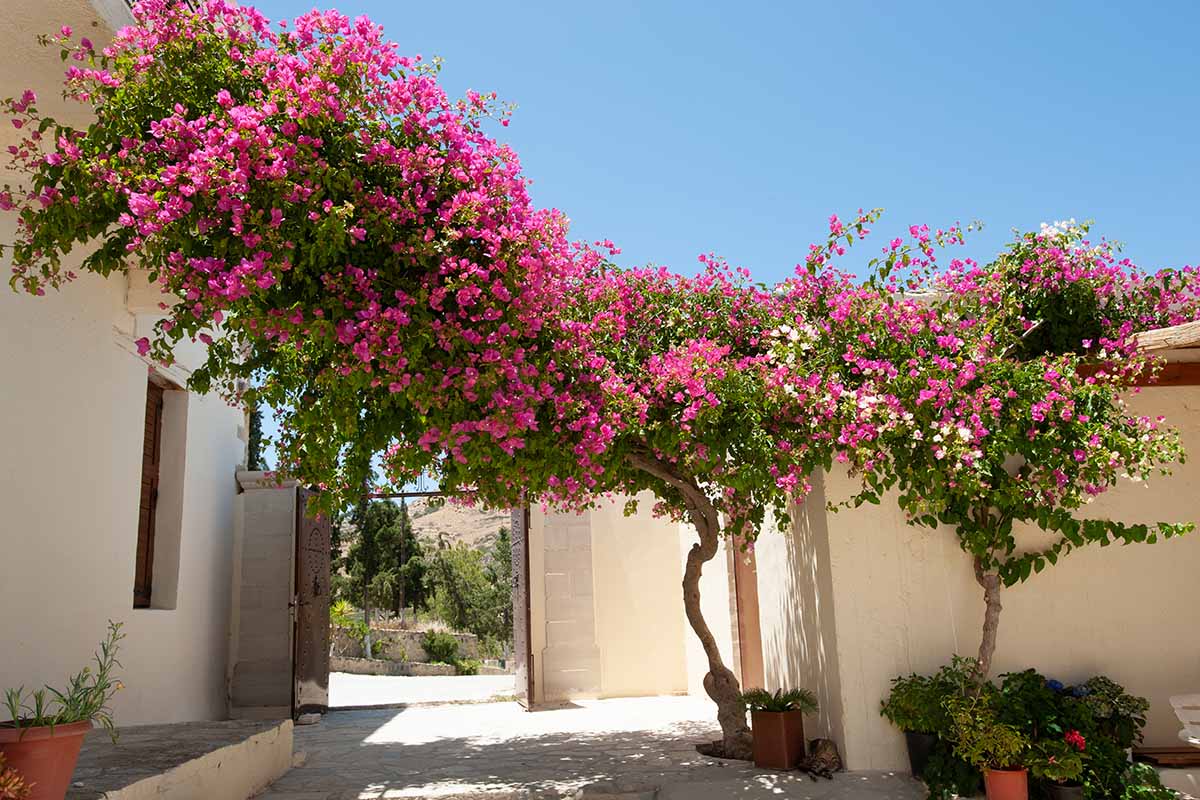
Let us know in the comments which paperflower you’ve already got growing at home, or which has caught your eye to install next. We love to see pictures of what you’re growing!
Of course, we have lots of other guides to growing vines with beautiful flowers available, check these articles out next:
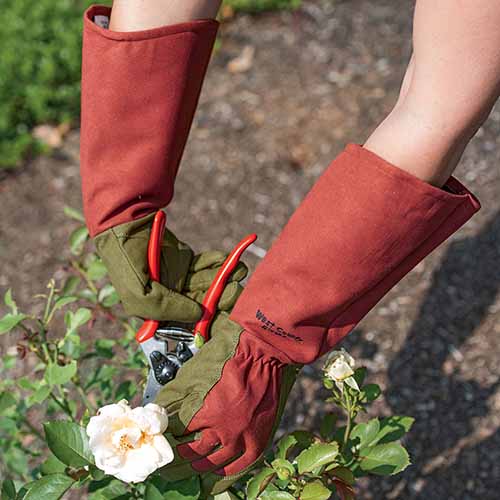

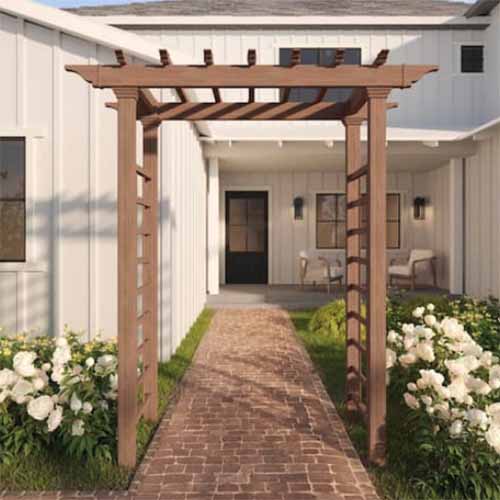
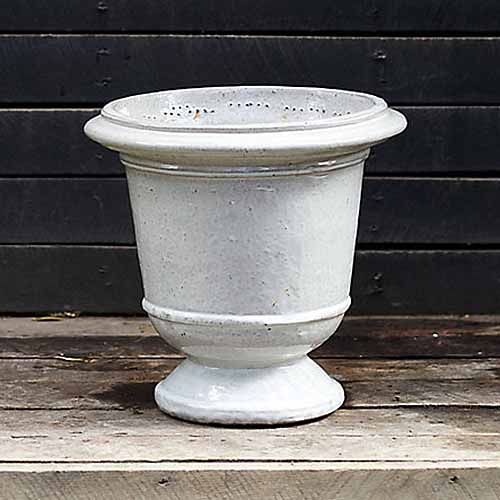
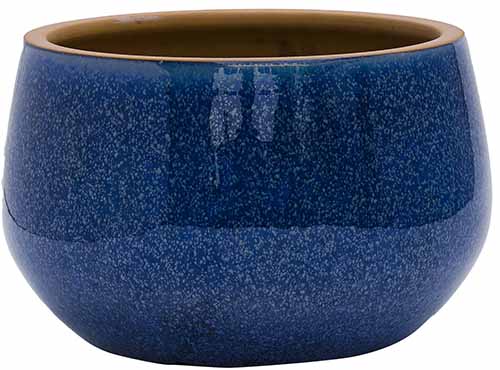

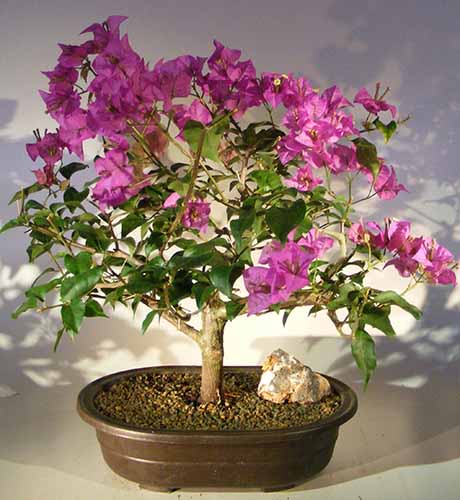

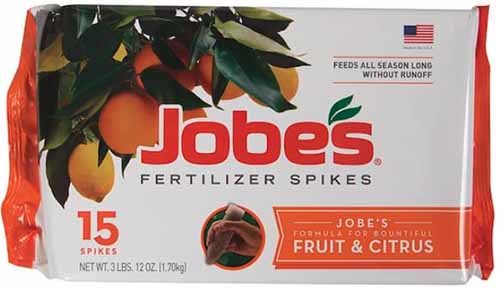

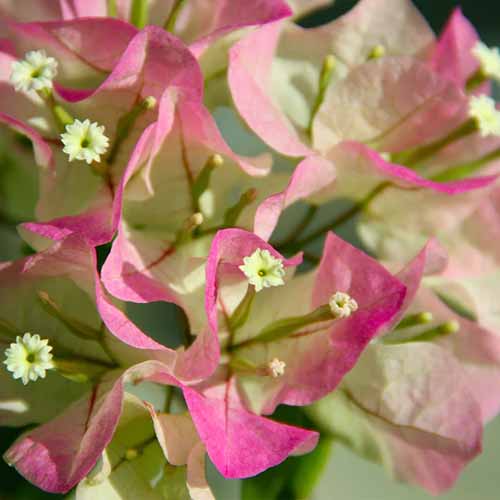
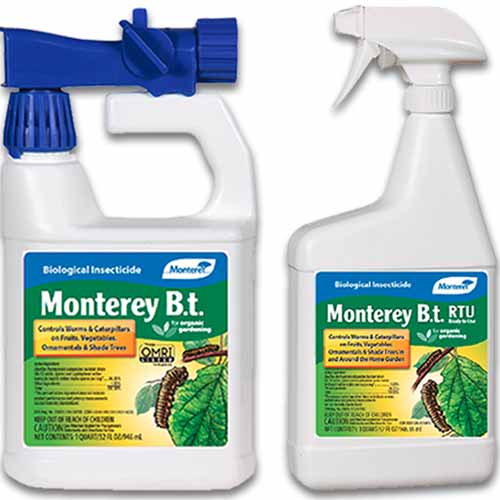
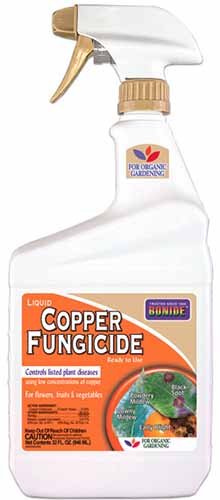
Thank you for this information!!!! I’m so in love and have bought 6 plants and counting and have a gardener Who is managing their growth but I’m so glad to be more informed about how to make them spread and thrive. Love from Lagos, Nigeria
Hi Bianca we’re so glad you found the article helpful. I lived in Lagos many, many years ago and our front fence was covered in glorious bougainvillea!
Banana peels work good for soil amendments.
Hi Jim, you’re right! We actually have an article about using banana peels in the garden here if you’re interested 🙂
Kelly, Thank you for all the wonderful informative information. Growing and taking care of those beauties will be alot more manageable and definitely a lot more easier. We so truly love the bougainvillea and their beautiful brilliant colors.
I have the Thai Delight. It did well and grew but every winter in California Zone 9, because of strong winds, all the leaves fall off and we’re left with just branches throughout all the cold months. It started blooming again in midsummer. Is this normal? The same thing is happening this year.
Hi Michael, yes, bougainvillea can be deciduous in cooler locations – if it’s flowering nicely during the summer then it sounds like it’s quite normal.
Could one plant a bougainvillea so it grows up a tall palm tree? Adding color to an otherwise plain sight?
Hey, Angie! That’s actually a really cool idea. Yes, I believe its possible to train a bougainvillea to grow up a palm tree. Since palm tree trunks don’t increase in girth, you’re actually more likely to succeed than if you were to try it on trees with secondary growth. However, there are some logistical issues that you may run into: 1. Plant selection – you’ll want to make sure that it’s a good pairing. A palm that’s too large will only have its trunk partially climbed, while a bougainvillea that climbs too high might spread into the canopy unless its… Read more »
This article is very informative but I’m still at a loss how to train my vines. They are trellised against the front of our stucco house up to about 10 feet but from there I have no idea what to do. I can’t ever see what’s under large climbing vines to get ideas. I’m wondering if I should just simply keep them pruned and compact to fit only on the existing trellis but I want so much more. I love these plants.
Bougainvillea can be trained to grow beyond your trellis but it must have support – the vines need something to twist through and they won’t grab onto walls on their own, like some other types of vines will. If you can attach wire to your stucco that goes beyond the existing trellis, for example, that could work.
Bought some ‘Purple Princess’ from HomeDepot to put around my curb. Suppose to bloom year-round, evergreen, a compact bush form up to 3’x3’. Really looking forward to this new variety. Hope the grower doesn’t give me false hopes. Would appreciate if you can include some information on how best to care for this variety to ensure year-round blooms and evergreen nature. I live in Zone 9. Thanks.
‘Purple Princess’ is a nice, year-round cultivar with a compact habit, so you won’t need to do much to maintain it! Given plenty of sun, is should put on a colorful show for you. As with other varieties, avoid overwatering. Once the plants are established, when you do water in the absence of rain, provide slow and deep irrigation rather than frequent, shallow sips.
I bought this plant 5 years ago. We live in NE Oklahoma so we have some pretty cold winters. It is in a large hanging pot. At the end of the season I trim it back to just larger that the pot, about 15 inches across and put it up in my garage which stays warm. I water it a little once a week. In the spring I just hang it back up on my pavillion and it grows out to about 6 feet in diameter.
Hello Larry. This is lovely, thanks so much for sharing the photo and your methods.